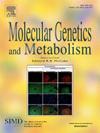Dual pathogenic mechanisms in lysinuric protein intolerance: Interplay between hyperammonemia and cellular metabolic dysregulation in astrocyte injury
IF 3.7
2区 生物学
Q2 ENDOCRINOLOGY & METABOLISM
引用次数: 0
Abstract
Background
Lysinuric protein intolerance (LPI) is a rare genetic disorder characterized by an inherited defect in cationic amino acid transport caused by pathogenic variants in the SLC7A7 gene. While LPI causes systemic complications, the underlying cellular mechanisms remain poorly understood. This study investigated the cellular characteristics of LPI, focusing on intracellular metabolite profiles and astrocyte response to hyperammonemia.
Objectives
To examine intracellular metabolite changes in LPI patients and to evaluate the response of patient-derived astrocytes to ammonia exposure.
Methods
Peripheral blood mononuclear cells (PBMCs) from three LPI patients and three healthy controls were analyzed for intracellular metabolite profiles using capillary electrophoresis-fourier transform mass spectrometry. Induced pluripotent stem cells were generated from a patient's PBMCs and differentiated into astrocytes. We evaluated LPI-astrocytes and their response to ammonia treatment by RNA sequencing, gene expression profiling, and cell viability assays.
Results
Metabolite analysis revealed significant intracellular metabolite imbalances in LPI patients, with increases of 21 metabolites including 11 amino acids. LPI-astrocytes exhibited distinct cellular characteristics regarding altered gene expression and enhanced cell cycle progression. When exposed to ammonia, the astrocytes demonstrated markedly lower cell viability and increased reactive oxygen species (ROS) production compared to control astrocytes. N-acetylcysteine supplementation significantly ameliorated ammonia-induced cytotoxicity.
Conclusions
SLC7A7 dysfunction leads to intracellular metabolite disturbances and an increase in vulnerability to ammonia toxicity through ROS production of astrocyte, suggesting hyperammonemia and amino acid deficiencies as potential therapeutic targets in LPI patient care.
赖氨酸尿酸蛋白不耐受的双重致病机制:星形胶质细胞损伤中高氨血症与细胞代谢失调之间的相互作用
背景:赖氨酸尿酸蛋白不耐受(LPI)是一种罕见的遗传性疾病,其特征是由SLC7A7基因的致病变异引起的阳离子氨基酸运输的遗传性缺陷。虽然LPI引起全身性并发症,但其潜在的细胞机制仍然知之甚少。本研究探讨了LPI的细胞特性,重点关注细胞内代谢物谱和星形胶质细胞对高氨血症的反应。目的观察LPI患者细胞内代谢物的变化,评价患者来源的星形胶质细胞对氨暴露的反应。方法采用毛细管电泳-傅里叶变换质谱法对3例LPI患者和3例健康对照者的外周血单个核细胞(PBMCs)进行细胞内代谢物分析。诱导多能干细胞由患者的PBMCs生成并分化为星形胶质细胞。我们通过RNA测序、基因表达谱和细胞活力分析来评估lpi星形胶质细胞及其对氨处理的反应。结果代谢分析显示LPI患者细胞内代谢物明显失衡,21种代谢物增加,包括11种氨基酸。lpi -星形胶质细胞在基因表达改变和细胞周期进程增强方面表现出明显的细胞特征。与对照星形胶质细胞相比,当暴露于氨时,星形胶质细胞表现出明显降低的细胞活力和增加的活性氧(ROS)产生。补充n -乙酰半胱氨酸可显著改善氨诱导的细胞毒性。结论sslc7a7功能障碍通过星形胶质细胞产生ROS导致细胞内代谢物紊乱和氨毒性易感性增加,提示高氨血症和氨基酸缺乏是LPI患者护理的潜在治疗靶点。
本文章由计算机程序翻译,如有差异,请以英文原文为准。
求助全文
约1分钟内获得全文
求助全文
来源期刊

Molecular genetics and metabolism
生物-生化与分子生物学
CiteScore
5.90
自引率
7.90%
发文量
621
审稿时长
34 days
期刊介绍:
Molecular Genetics and Metabolism contributes to the understanding of the metabolic and molecular basis of disease. This peer reviewed journal publishes articles describing investigations that use the tools of biochemical genetics and molecular genetics for studies of normal and disease states in humans and animal models.
 求助内容:
求助内容: 应助结果提醒方式:
应助结果提醒方式:


